A thank you note
November 25, 2014
This week marks the end of my 40-year career as an elected official in the City and County of Los Angeles.
Twenty years ago this month, I was sworn in as a member of the Board of Supervisors. On that day, I spoke of the huge challenges facing our county and of my promise to hit the ground running. I’d like to think that, as I pull up a seat today for my final board meeting, I kept pace with my aspirations and, more importantly, with your expectations.
I want you to know what a privilege it has been to serve you, both on the Board of Supervisors and as a member of the Los Angeles City Council for two decades. I’ve never taken these jobs or your trust for granted. I’ve always worked as hard on the day after an election as I did on the day before.
In recent weeks, I’ve been honored at a number of farewell events. But make no mistake, while I’ve been flattered by these gatherings, I’m under no illusion about where the real credit should go—to you, my constituents.
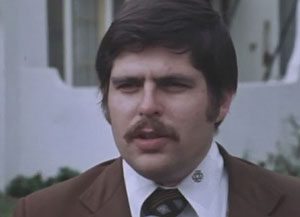
The supervisor during his first successful run for City Council in 1975. He'd serve there for two decades.
You entrusted me with elected office as a young man two years removed from graduate school, and you empowered me with a mandate to shake up the status quo and the forces that benefited from it. Throughout my career—whether I was confronting brutality in the Los Angeles Police Department, battling gender discrimination in the workplace or challenging the dysfunctional structures of government—you’ve had my back. My success was the direct result of your support.
Together, we’ve made lasting inroads across so many fronts, for so many people. With my superb and hardworking staff, we’ve created a widening mass transit infrastructure, preserved the Santa Monica Mountains for future generations, bolstered our public healthcare system, provided permanent supportive housing for the homeless, enhanced our cultural institutions and restored fiscal stability to our county. So I leave office satisfied that I have given my all on your behalf.
As for the future, I will continue to contribute my voice to the crucial issues that impact our region and its quality of life, albeit not from political office. I plan on writing a memoir, doing some teaching and being open-minded to whatever the future may hold. After so many years devoted to my work, I also plan on spending more time with my young grandchildren and, of course, with my wife and partner, Barbara, who did far more than her fair share of supporting my career and of raising our daughter and son.
On this Thanksgiving, perhaps more than any other, I’ll be reflecting on the incredible joys and rewards of my life. I take with me so many fond memories of the work we’ve accomplished together to make this a better city and county.
I thank you from the bottom of my heart.
Zev
Making tracks for a better future
November 25, 2014
Los Angeles’ subway is turning out to be the engine that could. A little more than 20 years after the first riders hopped aboard the first leg of the subterranean system, the network is getting ready to make tracks into the Westside, taking center stage in an unprecedented effort that will double Metro’s rail miles over the next two decades.
The Purple Line subway, which now runs from downtown only as far as Wilshire Boulevard and Western Avenue, will extend to La Cienega Boulevard by 2013, with stops at La Brea Avenue and the Los Angeles County Museum of Art, where officials recently held a ground-breaking ceremony to celebrate the coming of the line.
Funded in large part by Measure R—the half-cent sales tax approved by county voters in 2008—Los Angeles’ “rail-volution” heralds the region’s transition from smog-choked autopia to transit-friendly metropolis.
“It’s an amazing attitudinal shift,” said Art Leahy, Metro’s CEO. “Well into the 1980s people would say, as regards rail, ‘We don’t need that—this is not New York and it’s not Chicago.’ Well, you don’t hear that anymore.”
The Purple Line Extension is one of five major rail projects that are currently under construction, along with Phase 2 of the Expo Line, the Gold Line Foothill Extension, the Crenshaw/LAX Line and the Regional Connector. When fully built, the projects will add 37 miles of track and 30 stations, reaching destinations including Santa Monica, Little Tokyo, Beverly Hills, Azusa and Watts.
At the Los Angeles County Museum of Art groundbreaking ceremony, officials extolled the project’s benefits for transit riders and the community at large.
“It’s going to help people get where they need to go, cut traffic and boost our economy,” said Los Angeles Mayor Eric Garcetti. “Tens of thousands of jobs will be created because voters said, ‘We want to get this done.’ ”
Supervisor Zev Yaroslavsky called the occasion an “historic day for the Westside,” noting that the area has not seen mass transit for decades—since the demise of the fabled Red Car network. He also said that the traffic-plagued Wilshire corridor—home to popular destinations such as LACMA, the La Brea Tar Pits and UCLA—was the best place to get the most possible riders for the new line.
“It’s the densest corridor outside of downtown,” Yaroslavsky said. “I believe we’ll have over 100,000 people riding this line within a year of its opening.”
The Purple Line extension project is broken into three sections with a projected total price tag of $6.3 billion, from a mix of federal and local funds, including half from Measure R. When completed, riders will be able to get from downtown L.A. to Westwood in just 25 minutes. The first 3.9-mile segment of the subway, with stations at Wilshire/La Brea, Wilshire/Fairfax and Wilshire/La Cienega, is expected to be completed in 2023. The full extension will have additional stops at Rodeo Drive, Century City, UCLA and the Veterans Administration Hospital and is projected to wrap up in 2035.
The Westside doesn’t have to wait for the subway, however, to get its next rail infusion. Phase 2 of the Expo Line is on track for completion by the end of 2015. The line will bring trains to within blocks of the Pacific Ocean, ending at 4th Street and Colorado Avenue in Santa Monica and opening up transit options for millions of L.A. County visitors and residents. The beneficiaries will include Eastsiders like Metro’s Leahy, who lives in Pasadena. “I don’t go to the Westside often, even though I like the Westside, because it’s so hard to get around,” Leahy said. “It just takes forever to drive anywhere.”
The current rail expansion is the biggest of its kind anywhere in the United States, and transit advocates hope it will whet the public’s appetite for more. Plans for a new ballot measure that could fund additional projects are already in the works. While it’s too soon to predict what those plans will include, L.A.’s transportation makeover is already well underway.
L.A. County’s modern-day rail journey began in 1990 with the opening of the Blue Line, street level light rail that extends from downtown L.A. to Long Beach. Over the next decade, the Red and Purple subway lines opened in phases, connecting downtown to Koreatown, Hollywood and the San Fernando Valley. Meanwhile, the Green Line linked Norwalk and Redondo Beach in 1995. Additional lines have opened since then, including the Gold Line to Pasadena and, most recently, the first section of the Expo Line to Culver City in 2012.
Posted 11/25/14
Helping homeless families heal
November 24, 2014
Gabriele Gonzalez was living a hard life last winter. She was homeless and addicted to methamphetamine, sleeping in parks and abandoned buildings, unsure where she’d find her next meal.
Today, she’s headed in a dramatically different direction. She lives in a comfortable room in a freshly-refurbished residential treatment center, has a new job in customer service, and is looking forward to a possible reunion with the three children—aged 6, 8 and 10—who were taken away from her when she was at her lowest point.
Her transformation has not been a solo voyage. Crucial assistance is coming from the Via Avanta Residential Center in Pacoima, where a pilot program called “Project 60: Women and Children” is underway to help homeless women, particularly mothers, with serious mental illnesses.
The program marks the latest extension of Project 50, a pioneering “permanent supportive housing” program launched by Los Angeles County in 2007. It provided 50 of the most vulnerable homeless people on Skid Row with housing first, and then surrounded them with mental healthcare, substance abuse treatment and other services. Project 50-style programs have since expanded to assist nearly 1,000 people across the county, said Mary Marx, who oversaw the initial effort for the Department of Mental Health. The initial investment paid off, too—saving $4,774 per person over the first two years by keeping them out of jails and emergency rooms. And the model has spread to cities including Denver, San Francisco and Washington, D.C.
And, of course, to Pacoima, where for many in the women’s pilot program, the well-being of their children serves as a powerful motivator to turn things around.
“I had lost apartments, cars and jobs before, but I had never lost my kids,” said Gonzalez, 29, whose son and two daughters were removed last November by the Los Angeles County Department of Children and Family Services and placed with relatives. “When they got taken, I lost a big part of me. I couldn’t imagine having them grow up with the idea that I didn’t fight for them.”
At a court date last January, Gonzalez realized that she was running out of time to get her kids back. Motivated to take action, she turned to a list of help numbers provided by DCFS and decided to call Via Avanta, which is run by Didi Hirsch Mental Health Services. She moved in on February 5, 2014.
Kita Curry, president and CEO of Didi Hirsch, said that having children involved presents special challenges and raises the stakes of the housing program.
“We’re not just helping an individual get their life together; we’re helping a family get their future together,” Curry said. “Otherwise, these kids would be at risk of trouble at school, getting in bad relationships and repeating the cycle.”
Supervisor Zev Yaroslavsky—an early supporter and pioneer of the housing-first approach—identified $542,000 in 3rd District homelessness funding to refurbish one of two residential buildings at Via Avanta last year. Last month, he directed an additional $1.7 million to the facility to redo the second building.
Though only a year old, the women’s program already is making a difference. It has served 39 women since the beginning of 2014. All were homeless and suffered from severe mental illness. Many also came with substance abuse disorders. Some, like Gonzalez, no longer had custody of their children. Others were admitted with children in tow. So far, 16 have been discharged and 23 remain in treatment. Of those discharged, 88% went on to live in supportive housing or with spouses, family and friends. Half moved out with their children and the others continue to work toward reunification.
Unlike Project 50—which dealt with single homeless people, most of them men—this program must consider the safety of the children and the realities of parenting, Curry said. Raising kids can be stressful even without mental health issues and substance abuse challenges, so it’s important to ensure that the women can cope with those realities before they are discharged.
After moving in, Gonzalez felt an immediate sense of security knowing that her basic needs would be met. She began putting her life back together, piece by piece—going to group therapy sessions, working in the kitchen and attending classes on subjects such as parenting, safety, domestic violence and relapse prevention.
“At first I was very emotional,” Gonzalez said. “I would cry in every group. It was part of my healing process.”
After a month or so, Gonzalez was allowed to have visitors, but she first needed to mend the bridges she had burned with members of her ex-husband’s family, who have custody of her children. The kids now visit occasionally, and Gonzalez has tea parties, plays dress-up and reads to them. She’s seen them “about 10 or 11 times. I’ve had to sit back and be OK about the fact that I’m not going to get as many visits as other people, but I‘m doing what I can.”
In addition to working on mental health and substance abuse issues with counselors, she built a resume and did mock interviews at Chrysalis, a nonprofit employment agency that works with Via Avanta. After spending hours each day applying for jobs at the work center’s computers, three weeks ago she was hired to do customer service for online companies. She wakes at 4 a.m. each day to commute from Pacoima to her workplace in Glendale. In her spare time, Gonzalez plays piano and even sings in Via Avanta’s hallways. Her current favorite is “Someone Like You” by Adele.
Gonzalez is adamant about taking responsibility for her life, but, like many homeless women, she also must come to terms with a long series of youthful traumas, including rape, molestation and abuse. By 15 she was diagnosed with clinical depression. Married at 18, she spent the next 12 years in a troubled relationship and turned to drugs, she said, to deal with her inner pain.
At first, she was reluctant to accept help in coming to terms with her past.
“I guess I held that stigma that I’m crazy if I have to see a therapist,” Gonzalez said. “I was very anti-medication. But it made such a difference. The medication and therapy has helped me so much.”
Now she’s looking ahead to the new year. February looms as an important month. That’s when she expects to move from Via Avanta (the program is generally geared to short-term stays) and has a custody hearing scheduled on the 15th.
“Hopefully that will be the date that I reunite with my kids,” she said.
Someday, Gonzalez hopes to attend nursing school and help other women like herself, perhaps at a place like Via Avanta. But she doesn’t want to get ahead of herself. She planes to continue focusing on her mental health and substance abuse issues by staying in treatment and going to 12-step meetings.
“I’ve put in a lot of work but none of it would have been possible if I hadn’t come here,” Gonzalez said. “I’m looking at life in a new way. I love myself today.”
Posted 11/21/14
Zev’s L.A.
November 21, 2014
Learning lessons in healthcare
November 20, 2014
For years, teachers at Sun Valley Middle School used a 1.8-acre dirt expanse on campus to teach students the finer points of horticulture. But when Los Angeles County officials saw the empty land, they envisioned growing something else, something ripe for a neighborhood in need.
In 2008, the Sun Valley Health Center opened its doors, ushering in a new model of grassroots care in the county. Today, the $7.5-million, 11,000-square-foot community clinic racks up more than 28,000 medical and dental visits each year for ailments ranging from asthma to diabetes.
And patients are treated regardless of their ability to pay.
“It’s like a dream come true,” said Helen Arriola, governmental and community relations officer for the Northeast Valley Health Corp., a nonprofit tapped to provide low-cost or no-cost treatment at Sun Valley Health Center.
“There’s such a great need [for affordable care] in Los Angeles County, given the numbers of uninsured here,” Arriola said, recalling the crowds that lined up for vaccines at the health center as early as 4 a.m. during the 2009 swine flu pandemic. “We have to provide them with services — we can’t say ‘no.’”
The concept of school-based health centers has proven so successful that two more will soon become a reality on San Fernando Valley campuses that lie in what Supervisor Zev Yaroslavsky calls “ground zero” in the nation’s healthcare crisis.
The $11-million, 13,500 sq. ft. North Hills Wellness Center at James Monroe High School, which was dedicated last month, is scheduled to start serving patients in January. Meanwhile, construction is expected to soon be completed on the $6.2-million, 5,400-sq. ft. San Fernando Teen Health Center at San Fernando High School.
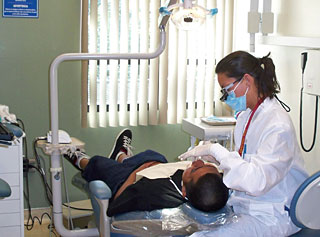
The Sun Valley Health Center has logged more than 28,000 visits annually for medical and dental services.
All three projects are joint ventures between the county and the Los Angeles Unified School District — the former building the health centers, and the latter supplying the land.
They are partnering with several private nonprofit healthcare groups to staff the facilities with physicians, dentists, optometrists, psychologists, nurses and other medical professionals.
“We started looking into health centers on campuses many years ago, because schools are centrally located in the lives of families,” Yaroslavsky said the recent dedication ceremony for the North Hills Wellness Center.
“This is an effort to take the real estate used by schools, and build things into it that would not just be looking inward to the schools but outward to the community,” he added.
Yaroslavsky allocated $24.7 million in Third District funds for the three projects, while the LAUSD covered the remaining $1 million.
North Hills Wellness Center, located at the corner of Nordhoff and Haskell, will be the most expansive, with 14 medical, dental and visual examination rooms, mental health and behavioral counseling offices, as well as a dispensary and laboratory.
It will also have a Teen Health Center that will offer confidential treatment to the growing number of youths dealing with mental illness, substance abuse, homelessness and other problems.
“This community is home to about 400,000 residents, and about 85 percent of them live at or below 200 percent of the federal poverty level — that’s an (annual) income of about $46,000 for a family of four,” said Dr. Roger Peeks, chief medical officer of Valley Community Healthcare, which will operate the wellness center.
“These are the people that we are going to serve,” he added.
The same nonprofit organization behind the Sun Valley Health Center will also operate the San Fernando Teen Health Center. Arriola said Northeast Valley Health Corp. is currently soliciting donations to buy furniture and medical equipment.
Initially, the teen center will treat only students from San Fernando High School, Mission Continuation School and McAlister School. But Arriola is optimistic that the clientele will expand.
“If you look at the construction site, the main door faces the street, and what we’re hoping is that sometime in the future, they’ll allow it to be open to the community, perhaps after-hours or on Saturdays,” she said.
The county’s community health programs director believes the school-based health center model should be replicated over and over again.
“What we know in pediatrics is that over half of the sick low-income kids in the US also have sick parents and sick friends, and the opportunity to serve them in one place is unusual, forward-thinking and fantastic for those families,” Dr. Mark Ghaly said. “We look forward to seeing this idea spread to more places,” he added.
D.A. sees new day for mentally ill
November 20, 2014
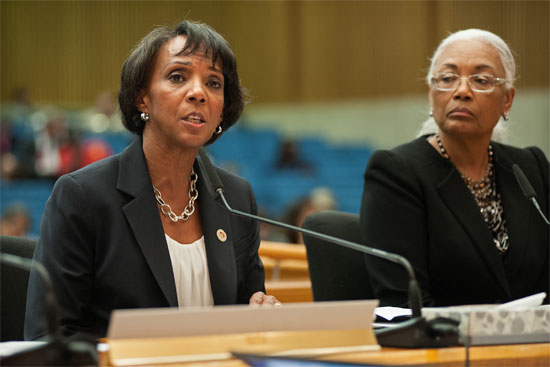
District Atty. Jackie Lacey tells the Board of Supervisors that jail diversion is “right within my mission.”
When Jackie Lacey won election as district attorney in 2012, no one expected the county’s chief prosecutor to become a crusader for taking people out of—rather than into—jail.
Yet this month, she was again center stage before the county Board of Supervisors to push for sweeping, if gradual, reforms to provide the mentally ill with alternatives to incarceration.
“Too often, our default position is to lock mentally ill people away because of a perception that there is no alternative,” Lacey said. “Well, there are alternatives — we just need to dedicate resources to expanding the capacity of those alternatives.”
Flanked by leaders of the county’s criminal justice system and social safety net, and with advocates for the mentally ill sitting in the audience, Lacey vowed to present a comprehensive report on diversion programs in early 2015.
She emphasized that initial goals for the Criminal Justice Mental Health Project should be “modest and achievable.” Progress, she said, would take time.
“I want to temper our expectations for a quick fix,” Lacey told the board, pointing out that the county is so large and complex that it’s “a country unto itself.”
Still, there is a sense of urgency to the undertaking, not just for mentally ill inmates whose conditions are worsening behind bars. The U.S. Department of Justice has accused the county of failing in its constitutional duty to adequately serve mentally ill inmates and will likely force the county into a court-supervised federal consent decree.
Although the board is weighing a $1.7-billion proposal to replace Men’s Central Jail with a Consolidated Correctional Treatment Facility, envisioned as “a treatment facility for inmates, construction won’t be completed for years.
The county does have diversion programs already in place for the mentally ill but none has the capacity to serve the vast numbers of people whose schizophrenia, paranoia, bipolar disorder and other conditions may cause them to run afoul of the law. An estimated 15 percent of county’s 20,000 inmates have been diagnosed with a mental illness.
A pilot program was recently created to provide permanent supportive housing for 50 chronically homeless, mentally ill people who’ve been arrested for low-level offenses in the San Fernando Valley. Championed by the office of Supervisor Zev Yaroslavsky, the Third District Diversion and Alternative Sentencing Program is envisioned as a potential template for diversion programs countywide.
Currently, the Department of Mental Health has only three psychiatric urgent care centers and three crisis residential treatment programs across the 4,000-square mile county, and 30 mobile crisis support teams to respond to emergencies, sometimes while partnered with sheriff’s deputies or police officers.
Thanks to a $40.1-million state grant, however, those services will soon be expanded. The board voted to double the number of its urgent care centers, and potentially multiply its crisis residential treatment programs tenfold. It authorized creating 11 more mobile crisis support teams.
In an interview, Mental Health Director Marvin Southard said only those who are not considered a danger to society would be eligible for diversion.
“If somebody has committed a serious crime, they need to pay the consequences,” he said. “Whether they happen to be depressed is really beside the point.”
DMH also has mental health professionals embedded in 22 courthouses, but Lacey acknowledged that some prosecutors and public defenders don’t utilize their services or even know they exist.
She said officers of the court, as well as law enforcement officers, need additional training to ensure the mentally ill receive treatment, instead of ending up behind bars. She said that training would be the “short term” goal of the Criminal Justice Mental Health Project.
County Supervisor Zev Yaroslavsky believes that having Lacey spearhead the county’s diversion efforts is a “game changer.”
“It’s one thing for a non-law enforcement officer to advocate for this sort of thing, but it’s another when one of the chief law enforcement officers in the county — in this case, the D.A. — gives this the imprimatur of acceptability,” he told her after her recent testimony.
“I think this will be a real revolution for the county,” he said. “And I hope that we have the political will to get it done.”
In an interview after her board appearance, Lacey said she sees diversion programs as being “right within my mission.”
“My mission is to seek justice,” she said. “The stories of people who have loved ones in jail, or who have been put in jail themselves while mentally ill, just speaks to me personally.”
Posted 11/20/14
Progress is in the bag at the beach
November 20, 2014
A wedding gown, a polar bear suit, even a fake human skull — volunteers have turned up all sorts of discarded items on Coastal Cleanup Day in Los Angeles County.
This year, along with the usual cigarette butts and crumpled cans, they found a gun near the Malibu Pier and a piece of a firearm under the Redondo Beach Pier, triggering police investigations.
And, of course, they also found another kind of scary item that always seems to turn up amidst the heaps of sodden shoreline garbage: the single-use plastic bag, which is among the 10 types of litter most frequently collected in the ocean, lakes, rivers, creeks and storm drains.
But these days, the tide may be turning against the bag.
“We’ve seen a significant reduction in plastic bags as a component of what’s collected,” says Department of Public Works recycling and waste reduction program manager Coby Skye.
He said that data compiled by the environmental organization Heal the Bay, which analyzes samples of the trash its members and volunteers haul out of coastal and inland waterways, tells the story. In 2010, an estimated 5,000 plastic bags were collected. In 2011 and 2012, that number dropped to about 3,000. And by last year, the count was down to some 2,000.
“It stands to reason there’s going to be less waste because we know fewer plastic bags are being distributed,” said Heal the Bay spokesman Matthew King.
The rapid decline of littered, single-use bags, according to King and others, is a direct result of bans enacted throughout the region in recent years, including one approved in Los Angeles County by the Board of Supervisors in November, 2010. That one is now widely credited with setting the stage for California to recently become the first state in the nation to restrict single-use plastic bags.
In California, almost 20 billion plastic bags are used each year, many of which end up as litter, creating urban blight and flooding hazards. Animals can get tangled up in them, or mistake them for food and starve to death.
Since discarded plastic bags are non-biodegradable, they could harm wildlife and the environment for hundreds of years, and possibly as long as a millennium. Supervisor Zev Yaroslavsky, after voting to approve the ban, called them “urban tumbleweeds.”
San Francisco passed the first ban in the state 2007. Soon following suit were Malibu, Manhattan Beach, Fairfax and Palo Alto. But there, the momentum stopped, when other municipalities were scared off by lawsuits pushed by the plastic bag industry, which accused cities with bans of failing to prepare required environmental impact reports.
The county rendered that argument moot in November 2010 by passing an ordinance with an accompanying environmental impact report that focused on all cities within its boundaries, not just unincorporated areas.
“Soon after, jurisdiction after jurisdiction adopted bans,” Skye said, adding some of them copied the county’s ordinance verbatim and many of them relied on its environmental impact report.
“I think the fact that the county did it on a large scale made other regions more comfortable,” King said.
The city of Los Angeles became the largest city in the nation to ban plastic bags when it adopted an ordinance in June, 2013, that relied on data in the county’s environmental impact report.
The state, in its recent ban, also relied on the county’s ordinance.
Authored by state Senator Alex Padilla (D-Pacoima), SB 270 bans groceries and pharmacies from distributing plastic bags after July 2015. Convenience and liquor stores must comply a year later.
The state law would also provide up to $2 million in loans to businesses transitioning to manufacture reusable bags.
The plastic bag industry, however, is petitioning to repeal SB 270, arguing that 30,000 jobs are at stake and that unwashed reusable bags can breed dangerous bacteria.
In a statement posted on the American Progressive Bag Alliance website, Plastics Industry Trade Association President William Carteaux said: “The truth is singling out one product that makes only less than one percent of the U.S. municipal solid waste stream will have no meaningful impact on reducing litter,” he added. “Instead, it will result in forcing consumers to use products such as reusable bags, which are mostly imported from China, made from foreign oil and are not recyclable.”
If the Alliance can gather half a million signatures over a 90-day period to qualify a referendum, then the statewide plastic bag ban would be suspended pending the results of the November 2016 ballot.
King believes voters should uphold the ban.
“People often wonder, ‘Don’t we have bigger issues to worry about than plastic bags?’ ” he said. “Certainly, the state and the world are grappling with a lot of major issues but I do think plastic bags are important.”
“I like to call them a gateway issue because it gets people thinking about the impact of their other habits on the environment,” he added. “After a conversation about plastic bags, you might also start wondering, for example, whether to use single-use plastic water bottles to your kids’ soccer game or just bring a big thermos. It’s very positive to have this process, this debate.”
Posted 11/20/14
Framing the future of L.A. art
November 14, 2014
It’s been dubbed L.A.’s living room, and the coming transformation of the Los Angeles County Museum of Art promises that, artistically speaking, we’ll be living large for generations to come.
LACMA embarked on an ambitious new course recently with the announcement of the largest art gift in its history from entertainment mogul A. Jerrold Perenchio, just a day after the county Board of Supervisors unanimously gave conceptual approval to a plan to help fund a dramatic new Wilshire Boulevard-spanning museum building by acclaimed architect Peter Zumthor.
Perenchio’s collection includes spectacular but until now rarely-seen works by a range of celebrated European artists, including Claude Monet, Pablo Picasso, Edgar Degas, Edouard Manet and René Magritte. The 47 works are to join LACMA’s collection following Perenchio’s death, but the public will have a chance to view some of them at a special exhibition next spring, when the museum celebrates its 50th anniversary.
The infusion of art and architecture comes as LACMA’s attendance is surging and the rest of Los Angeles County’s cultural landscape is enjoying exponential growth.
“What’s happening here at LACMA is really emblematic of what’s happening in arts and culture in Los Angeles County and the region,” Supervisor Zev Yaroslavsky said, ticking off a 15-year run that has included two new pavilions at LACMA, the opening of Walt Disney Concert Hall, extensive renovations to the county’s Natural History Museum and the Hollywood Bowl, establishment of the Colburn Conservatory of Music and the debut of a new Valley Performing Arts Center at Cal State Northridge, among other highlights.
“If we had just done one of them, or two of them, we would have called it a good decade and a half. But we’ve had all of them,” Yaroslavsky said.
There’s more in store. The Hollywood Bowl this winter will be finishing a series of inside-the-amphitheatre improvements that already have brought patrons amenities like LED screens, updated picnic furniture and new bench seats. The county’s Ford Amphitheatre has embarked on an ambitious overhaul to replace its stage, shore up and re-landscape its scenic hillside and create a striking new terrace dining-and-concession area. On LACMA’s west campus, a new movie museum is about to rise. And LA Opera has launched a new tradition of bringing free, live outdoor simulcasts to audiences outside the Civic Center.
Nowhere is the excitement more visible than at LACMA. Yaroslavsky has coined the term “L.A.’s living room” to describe the museum campus’ around-the-clock pull on visitors, who make themselves at home with activities ranging from outdoor summer jazz to school field trips to photo ops in front of Urban Light to early morning jogs under Levitated Mass.
“When you come here even at 6 in the morning, as I do from time to time, or at midnight, this place is humming,” Yaroslavsky said.
Since the arrival of director Michael Govan in 2006, the museum has made Chris Burden’s Urban Light a crowd-pleasing beacon along Wilshire, created a communal touchstone across Southern California with the rolling of the massive boulder at the heart of Michael Heizer’s Levitated Mass, and doubled its attendance to 1.2 million annually.
Now things are about to get really interesting.
The masterpieces in the Perenchio collection will make their permanent home in the new building being designed by Swiss architect Zumthor, winner of the 2009 Pritzker Prize.
If all goes as planned, the sinuously curved new building should be completed by 2023, just as the Purple Line subway extension reaches the museum as part of its westward march.
The trifecta of the new building, the masterworks from the Perenchio collection and the arrival of the subway promises to accelerate LACMA’s momentum well into the future.
“The museum has become a cultural force in the community, and the Zumthor building will carry it into the 21st Century and beyond,” Perenchio, 83, said at the news conference celebrating his gift to the county museum.
Perenchio, the former chairman and CEO of Univision, has made previous donations anonymously. He said he went public this time in hopes of spurring others to contribute artworks and money to LACMA as it prepares to build the new structure.
Under the plan unanimously approved by the Board of Supervisors, the county has agreed to provide $125 million for the new building, which would replace four aging structures on the museum’s campus. But under the agreement, LACMA’s board must raise $475 million in private funding to make the building a reality. Perenchio said he hoped his gift would “encourage all types of donations, large and small—hopefully more large than small.”
“We have to make the Peter Zumthor building a reality,” he said. “Failure’s not an option here. We’ve got to do it, for the city and everybody who lives here.”
Posted 11/14/14




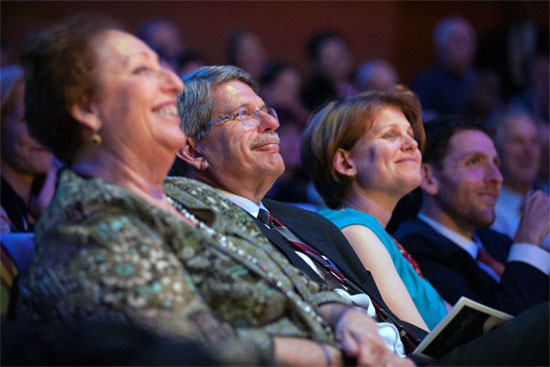
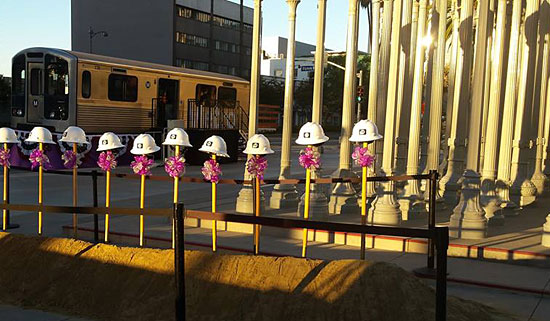
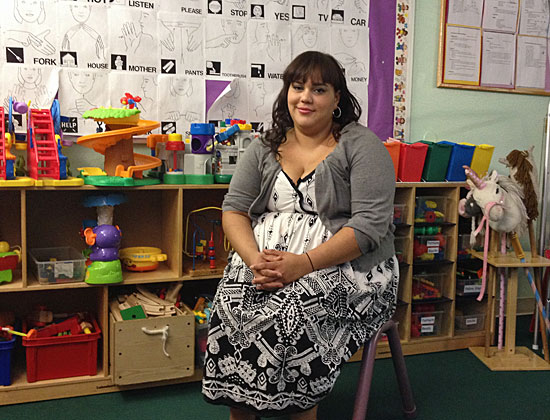
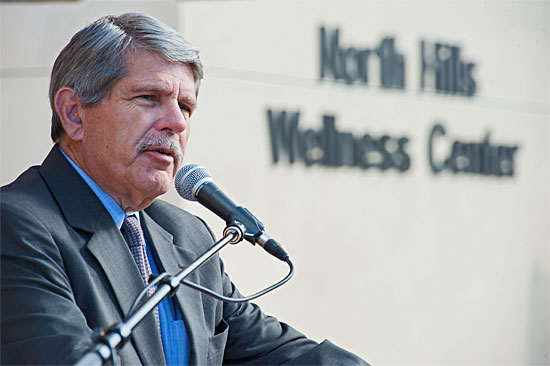
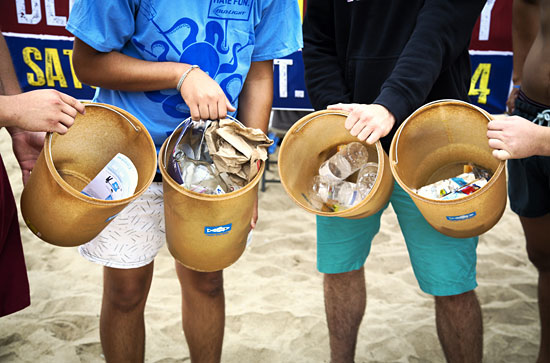
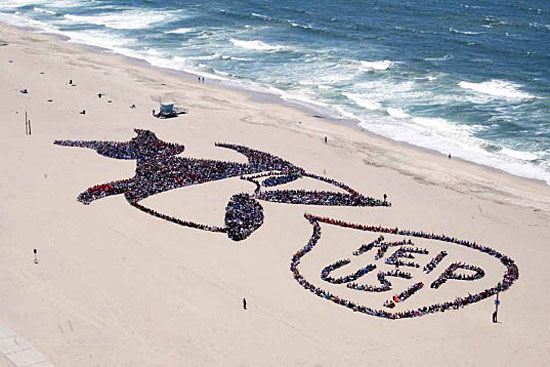









 Check for the latest closure information
Check for the latest closure information








